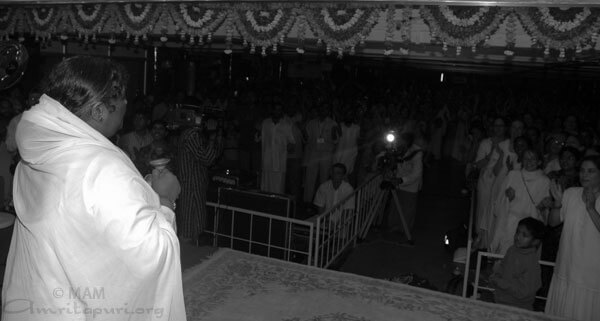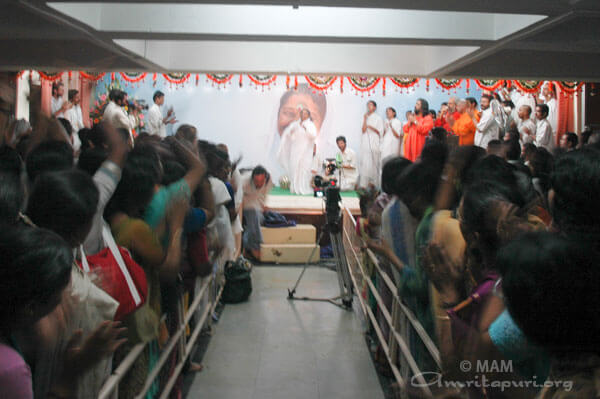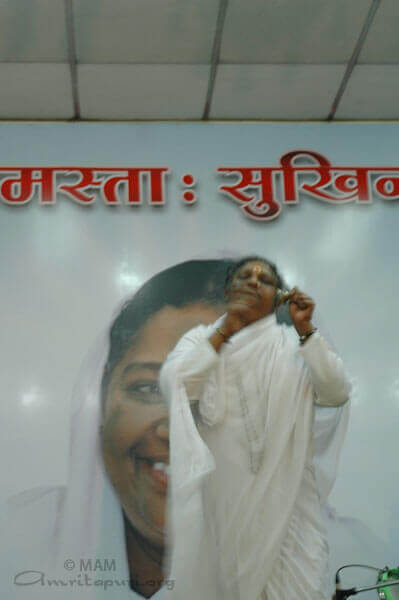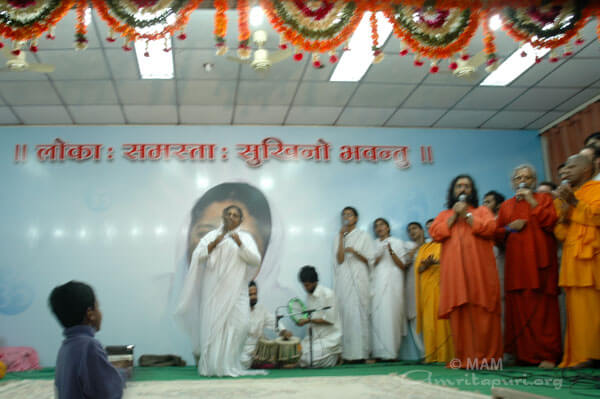27 February, Sivaratri — Nigdi, Pune, Maharashtra –Bharata Yatra 2006
The Shivaratri {news} celebrations were in full swing. Amma’s Pune devotees and the devotees and disciples accompanying Amma on her tour had been singing bhajans in the Pune Ashram darshan hall since 6:00 p.m. The energy level was high, as bhajan after bhajan were being offered to Lord Shiva. Would Amma come and join them in the nightlong celebration? It was the question on everyone’s mind.

Then, at 10 to midnight—in the middle of one Brahmachari’s ecstatic rendition of “Shankara Shiva Shankara,” Amma suddenly appeared. Of course, everyone rose to their feet, and Amma walked into their midst.
Would Amma sing bhajans with them? No, she would dance.
Amma took to the stage, which was already decorated for the next morning’s darshan, and said, “Dance, trying to see yourself as your ishta-devata [beloved deity].”

Someone then handed Amma a pair of kai-manis [hand cymbals], and then Swamis began to sing to the accompaniment of tabla and harmonium.
Bolo bolo sab mil bolo 'Om namah Shivaya'
Bolo bolo sab mil bolo 'Om namah Shivaya'
Jut jata me Ganga-dhari
Trisula-dhari damaru bhajave
The tempo was fast, and Amma moved briskly, stepping side to side to the beat. Her eyes were closed, and even though she wasn’t mic-ed, those close to the stage could clearly hear her voice. It truly was an ecstatic dance, full of energy. Surely many thought of Nataraja doing his dance of destruction at the end of a cycle of creation1.

At one point, Swamiji stopped the song, but Amma kept dancing—the ring of her kaimani, the sound of her footsteps and the clapping of the devotees were her only music. Almost right away, Swamiji and the harmonium and tabla, of course, started up again. Amma danced for a little while longer, and then when she was finished she sat down on the floor in meditation.
Amma remained like that for some time, and then stood up and began distributing pieces of apple to all the devotees.
For the Pune devotees observing the traditional Shivaratri vow of no food and no sleep, Amma’s appearance was an inspiration, replenishing their strength and sharpening their focus. For those travelling with Amma, it was also a treat—seeing Amma in Shiva Bhava. But in terms of tapas [austerities], almost every night on the India Tour is a Shivaratri.
—Kannadi

* Every object—whether it be an animal, a plant, a human being, a world, a universe or a thought—undergoes the process of creation, sustenance and destruction at every moment. Lord Shiva represents the destruction principle. In the Puranas, the end of a cycle of creation is mythologized by Nataraja (a name for Lord Shiva meaning “the King of Dance”) doing his dance of destruction. Death of a flower-bud is the birth of a flower. Death of a flower is the birth of its seed.
